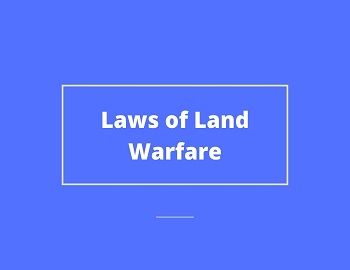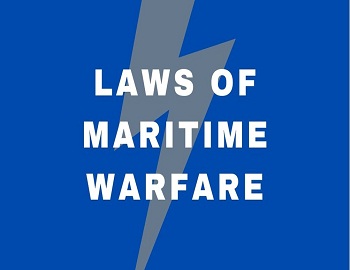Laws of Land Warfare:
War is an armed contest between two or more nations. In this contest, each party tries to overpower its opponent. The rules which regulate the conduct of belligerents in war operations on land are known as laws of land warfare.
The rules of land warfare are broadly set out in the Hague Convention IV of 1907, and the Geneva Convention of 1949. Prior to and after these two conventions some other conventions and declarations had laid down laws of land warfare. Among these other conventions, the notable ones are the Geneva Convention of 1884, Declaration of St. Petersburg 1808, Hague Convention of 1809, Protocol of 1925 and Geneva Convention of 1929. The following is a brief summary of these rules-
(1) The Hague Regulations defined the status of belligerents i.e., those who will be treated as lawful combatants. To constitute lawful Combatants, the troops must-
- Be properly commanded.
- Have a fixed distinctive emblem recognizable at a distance.
- Carry arms openly.
- Conduct their operations in accordnace with the laws and customs of war.
(2) The Hague Regulations forbid the use of the following methods and means of war.
- Painful instruments of war especially the poison or poisoned weapons.
- Asphyxiating of delterious gases, the dum dum bullets.
- Killing or wounding treacherously individuals belonging to the hostile nation or army.
- Misleading of enemy by treachery or perfidy.
- Improper use of a flag of truce, of the national flag or of military insignia and unfiorm of the enemy.
- Killing or wounding of the enemy who has surrendered.
- Attack or bombardment of undefended cities, villages and buildings.
- Compelling the subjects of the opponent belligerent to take part in the operations of war directed against their own country.
- Destruction of enemy property unless demanded by military necessity or the pillage of town or place when taken by assault.
Unfortunately, however, the above rules were observed in both the world wars more in their breach.
During the First World War libraries and cathedrals were either burnt or destroyed. But, as Fenwick observes, “It remained for the Second World War to impress devastation on a scale, which made a mockery of the prohibitions of the Hague Conventions. Enemy property of every character was seized without regard to its public or private character. Vast areas in Rusia were laid waste in the path of the advancing German armies and even more in the wake of their retreat”.
The Hague Regulations of 1907 also contrived provisions relative to the treatment of provisions of war. The Geneva Convention of 1949 dealt with this topic more exhaustively. At the Geneva Convention of 1949, four conventions were concluded, relating to-
- The treatment of prisoners of war.
- The amelioration of the condition of the wounded, and sick in Armed Forces in the field.
- The amelioration of the conditions of the wounded, sick and shipwrecked members of armed forces at sea.
- The protection of civilian prisoners in time of war.


![President of India [Article 52-62]- GK 3 President of India](https://gkscientist.com/wp-content/uploads/2021/05/President-of-India-Article-52-62.jpg)






Comments (No)